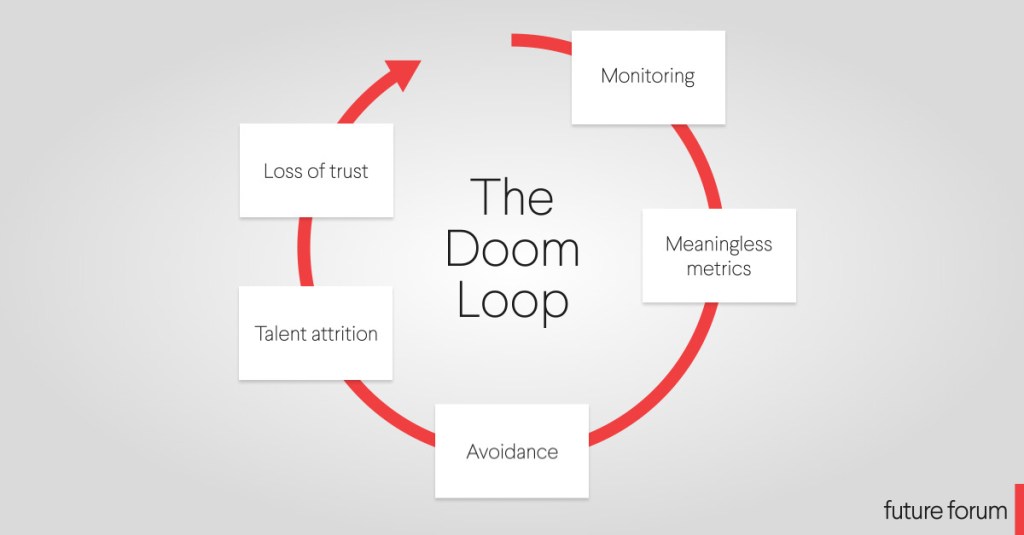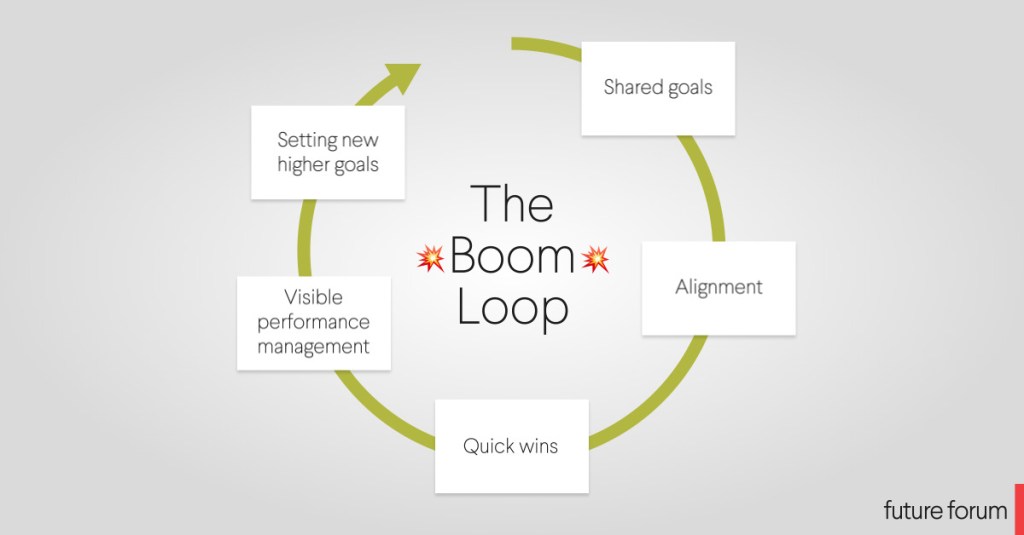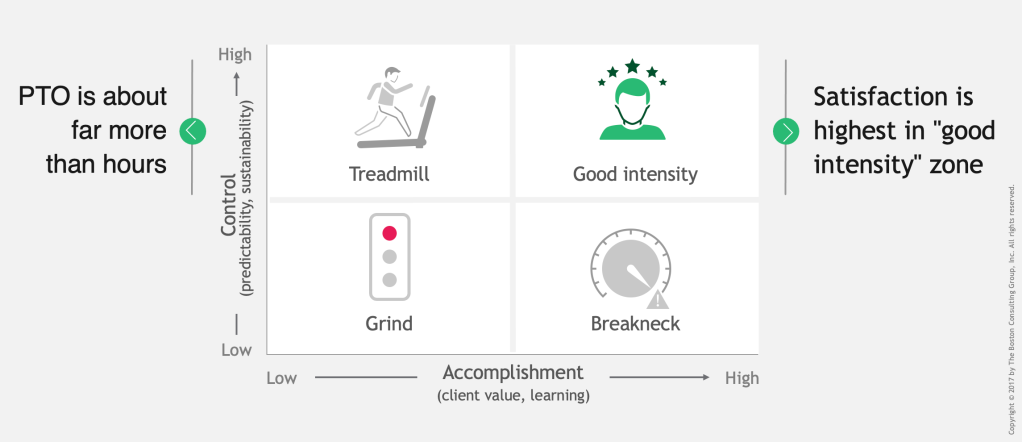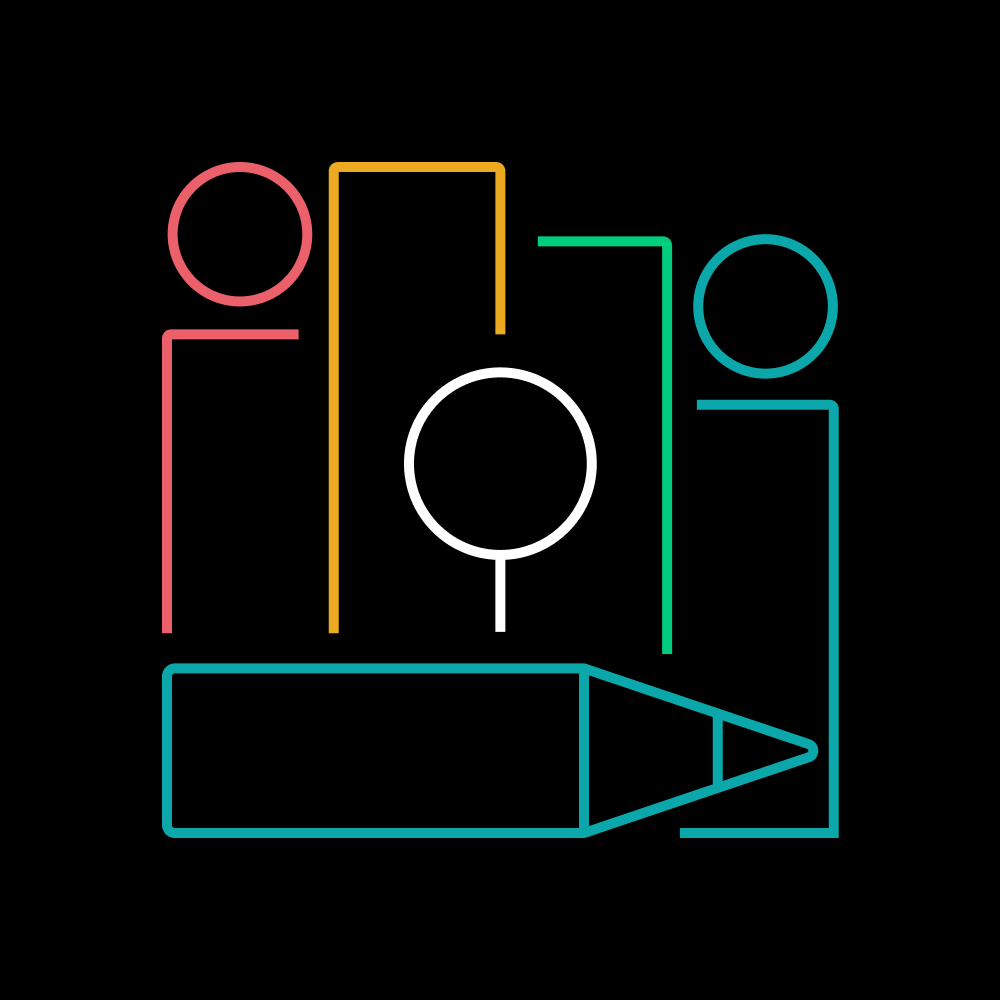
Measuring success in a digital-first world
A playbook for leaders looking to learn how to measure outcomes and build a culture of trust and accountability
Posted October 5, 2021 by Helen Kupp
This blog was co-written by Helen Kupp, Director at Future Forum, and Debbie Lovich, Managing Director and Senior Partner at Boston Consulting Group (BCG).
Boston Consulting Group is a founding partner of Future Forum. For more information, please read about the partnership.
Attendance. Hours logged. Speed of response. Back when the work day occurred in cubicles, this kind of over-the-shoulder employee monitoring was de rigueur. For workers, getting ahead too often meant being the first to arrive at the office and the last to leave, independent of how much work was actually getting done.
When the pandemic forced companies to go remote overnight, leaders scrambled to adjust. And many struggled. “WFH is corroding our trust in each other,” trumpeted Harvard Business Review. Remote surveillance software like Sneek, Intergard, and Hubstaff saw record usership and profit, as bosses sought digital tools to apply the old standards of in-office monitoring to our new work-from-anywhere world.
Meanwhile, employees began to vote … with their feet. Between April and June of 2021, 11.5 million American workers quit their jobs, and this “great resignation” groundswell shows no signs of slowing. New data from the Future Forum Pulse reveals more than half of workers across the globe—57%—are open to looking for new opportunities in the coming year, and key groups such as employees of color and working parents are even more likely to make the jump.
As leaders begin to roll-out new workforce policies, concern about employee retention is the number one driver influencing their decisions. But leaders who want to hold on to top performers need to stop looking over their team’s shoulders and start investing in cultivating their trust—and deepening their engagement.
“For too long, we’ve let managers rest on the wrong type of measurements—often at the expense of employee engagement and the literal expense of bottom-line business results,” says Brian Elliott, Executive Leader of Future Forum. “To achieve success in our digital-first world, managers need to stop focusing on inputs and start focusing on measuring outcomes.”
This playbook is for leaders who want to learn more about:
The problem: avoiding the “Doom Loop”
Expectations for knowledge workers are clear: employees want flexibility. Future Forum data shows that when it comes to employee satisfaction, flexibility is second only to compensation. Seventy-six percent of knowledge workers in our global survey report they want flexibility in where they work. And 93% want flexibility in when they work.
SEE THE DATA – Download the Fall 2021 Future Forum Pulse report
Back in May when virus numbers were waning and a return to the office seemed imminent, prominent executives were bullish about bringing employees back to the office and back to “normal.” But with new variants threatening to extend into a “pandemic era,” “employees have the upper hand in the war over remote work.” As flexibility becomes the global standard, even the most traditional sectors like banking, finance, and retail are getting on board, setting off a race of employers rushing to one-up each other in flexible offerings.
With the rise of remote and asynchronous work comes the revelation that traditional productivity and performance measures don’t work—they haven’t for a long time and they’re even more ill-suited to managing teams in a digital-first world.
According to future-of-work experts Heidi Gardner and Mark Mortensen, that’s because monitoring employee facetime, presenteeism, keystrokes, or hours logged works against the science of building trust. “Research shows that the more you trust someone and act accordingly, the more likely they are to trust you in return,” say Gardner and Mortensen. Trust is reciprocal. “Monitoring fails because it tries to solve the wrong part of the trust equation—it’s about managers trying to eliminate the space for vulnerability.”
Leaders who make the mistake of attempting to carry over the old “command and control” measurements to our new more flexible work reality risk running into a dreaded “Doom Loop” of meaningless monitoring that degrades trust and pushes top talent out the door.

The context: outcomes over outputs
Leaders who are used to managing through monitoring team inputs and outputs—from attendance to keystrokes, to hours worked, to tickets closed—often struggle to identify outcomes—the changes your team is trying to achieve in your business or with your target audience.
When you base your success measures on inputs and outputs, you get quantity—more software updates, more user tests, more documentation, more posts—more team activity. But that’s not the same as quality—and can even run counter to results. “Productivity has always been a good way to measure the impact of machines and capital,” writes Dominic Price for Atlassian. “It’s just never been a good way to measure the impact of humans.”
Measuring to outcomes, however, “encourages an ownership mindset,” says Price. “When we’re focused on productivity, we manage toward deadlines… By contrast, managing toward outcomes leads us to ship some work, gather feedback on it, and iterate as many times as we need until the result is actually, verifiably achieved. This encourages every employee to think like an entrepreneur.”
The solution: from doom to boom

For many leaders, managing to outcomes will be a new skill, which means developing new habits followed by lots of practice and reinforcement. And as with many new skills, the first step is often the hardest—how do you identify the most meaningful outcomes for your business?
“We often come into situations with our own perception biases,” says Goel. “We might think that similarly situated teams are having the same collaborative experience. However, objective data, such as data on underlying network dynamics, can reveal the different realities of teams in the same situation. It can also assist leaders in identifying which teams may need support before employee experience erodes.”
How organizations are measuring team success: Boston Consulting Group
For Boston Consulting Group (BCG), measuring success boils down to two questions.
“First we look at, ‘Is the team delivering value to the client?’ Second we ask ‘Are we delivering that value in a skill-building, rewarding, and sustainable way?’—with the latter measured by cultural factors that promote predictability, learning, recognition, and psychological safety,” says Debbie Lovich, BCG Managing Director and Senior Partner.
BCG is so committed to employee engagement as a key outcome that it’s developed a global program called PTO (Predictability, Teaming, and Open Communication) devoted to supporting and improving employee experience on projects and ensuring a sustainable workload without sacrificing client value.
The BCG PTO program

Teams are surveyed throughout the project and results are shared in a simple dashboard that shows a spectrum from positive (green) to negative (red). “So if the case team dashboard is red, then you know we need to start stepping through some interventions,” says Lovich. “PTO helps us not have to wait weeks or months to make the experience better for our case teams.”
Investments in employee engagement—like BCG’s PTO program—have far-reaching payoffs. Research shows that higher employee engagement leads to positive outcomes across the business, from increased operating margins, gross profit, and annual revenue to higher customer success and lowered attrition.
How organizations are measuring company success: Dropbox
The shift to virtual-first inspired Dropbox to “spend a lot of time discussing how to default to solving problems asynchronously and looking at performance based on results, not ‘busyness,’” says Chief People Officer Melanie Collins.
In the process, the company of nearly 3,000 people broadened the key business outcomes it measures:
- Business results: are we performing as a company and meeting our financial goals (revenue, bottom line)?
- Progress against our product roadmap: are we accelerating our company mission with new features that support distributed teams?
- Talent: Are we becoming more distributed as an organization? (both through hiring and relocation?) Are we becoming more diverse as an organization?
- Adoption: Are we adopting new ways of working? (asynchronous by default, core collaboration hours, virtual tools and tech like Miro)
- Employee engagement: are we building virtual-first community and belonging? Are we shifting from office/perks-centric to flexibility-centric? Are employees part of this change vs. having the change happen to them?
Since implementing new approaches to achieve these measures, Dropbox has seen a threefold increase in applicants and a 15% faster time to hire. Despite that initial success, however, Collins says the company is still taking a learning approach.
“We know we won’t get everything right,” says Collins. “[This is] a deliberate shift in our value proposition away from in-office entitlements and perks toward flexibility and work/life harmony. We need to share results transparently and be willing to undo things that don’t work. We need to show that we’re taking employee feedback continuously.”
Conclusion
This isn’t just about better measures—it’s about changing the role and responsibilities of managers on a fundamental level.
Moving from monitoring outputs to measuring outcomes frees your teams from the management practices of a bygone era—and creates opportunities to transform your organization from the inside out.

